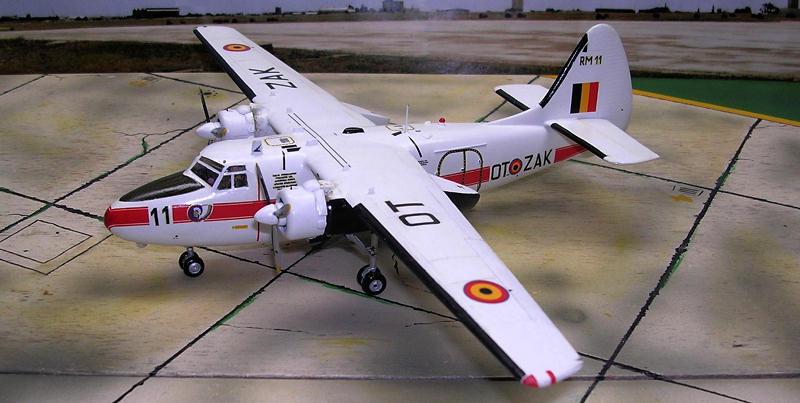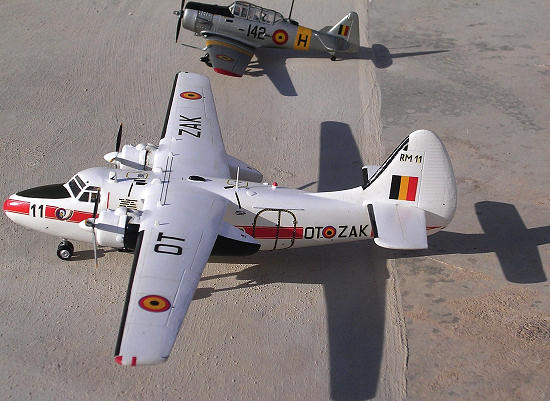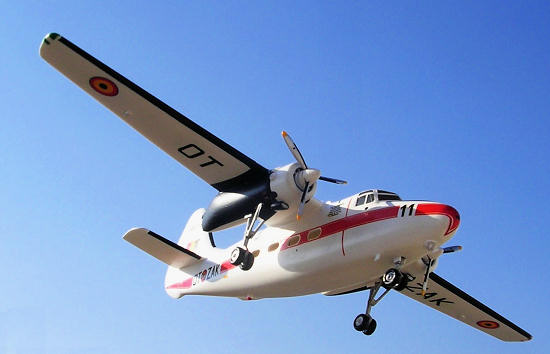
AU 16e Escadron 1/72 Pembroke Mk.51
| KIT #: | ? |
| PRICE: | 5LM when bought 1984 (equivalent to 15$) |
| DECALS: | Three options |
| REVIEWER: | Carmel J. Attard |
| NOTES: | limited run injection moulded kit with extra parts for two optional versions. |

| HISTORY |
The Pembroke
was a development of the Percival Prince civil transport. It had a longer wing
to permit a higher fully laden weight. The prototype flew on 21 November 1952.
Production was complete in early 1958.
It entered
service with the Royal Air Force as the Percival Pembroke C1 in 1953 to replace
the Avro Anson for light transport duties. As with other RAF transports
passenger seats are rearward facing for improved safety. Six were produced as
the Pembroke C(PR)1 photographic reconnaissance aircraft. these saw use by No 81
Squadron during the Malayan Emergency. The
 RAF's Pembrokes were modified to
extend their lifespan in 1970. The last unit to use them was No 60 Squadron RAF
based at RAF Windenrath in Germany, these were withdrawn from use in 1988 and
were replaced by the Hawker Siddeley Andover.
RAF's Pembrokes were modified to
extend their lifespan in 1970. The last unit to use them was No 60 Squadron RAF
based at RAF Windenrath in Germany, these were withdrawn from use in 1988 and
were replaced by the Hawker Siddeley Andover.
The Finnish
Air Force operated two aircraft for aerial photography between 1956 to 1968, on
behalf of the National Land Survey in Finland. One of the aircraft was destroyed
when it hit a snow wall during landing in 1965. The other aircraft is currently
stored at the Aviation Museum of Central Finland.
Pembroke C.1
WV740 (G-BNPH) is privately maintained in RAF markings in the U.K.
(2009) and gives flying displays.
Pembroke Mk.
51 s/n K66-B4001 is located at the Essex County Airportin
Fairfield , New Jersey. The aircraft was built in 1953 and last served
with the Belgian Air Force. The left engine is inoperable and the aircraft is
damaged and in a deteriorated condition. It was offered as a war bird contest
prize in spring 2009.
 Pembroke Mk 51
s/n K66-4002 reported to be located at Pierce County Airport, Washington State.
Total time ac 5757.5, port engine 6 smoh, starboard engine 2679.9 smoh, prop
times unk. Aircraft was fairyable 9/11/20001. It has been at the Pierce County
Airport since. Could be fairyable again in a short time. As of this date,
11JAN10.
Pembroke Mk 51
s/n K66-4002 reported to be located at Pierce County Airport, Washington State.
Total time ac 5757.5, port engine 6 smoh, starboard engine 2679.9 smoh, prop
times unk. Aircraft was fairyable 9/11/20001. It has been at the Pierce County
Airport since. Could be fairyable again in a short time. As of this date,
11JAN10.
Belgian Air Force keeps its RM7 at their Melsbroek premises just across the military air terminal. Pembroke OT-ZAK (RM11)was one of 12 C Mk51s used by the Belgian Air Force No 15 Wing, 20 Sq based at Melsbroek for communication work. It was originally supplied in silver overall finish before all the Pembroke fleet was painted in overall white with red cheat lines runs along the fuselage and black lettering.
| THE KIT |
There must be
at least four kit manufacturers that I know of who produced the Pembroke to a
scale of 1/72., in either injected or vacuum formed. One of these being the
Belgian supplier AU 16e Escadron. This kit appeared on the market back in mid
80s. and shows itís age as compared to kits of nowadays. Injected in white thick
plastic, the fuselage is split vertically, main wing parts come
in top and bottom parts , there are 52 components giving option to make
either a glazed nose version or one with a solid nose. Parts are clearly mold ed
and there are accurately cut fuselage windows., four apertures on port
fuselage side and five on starboard side. While this is so, the kit decal sheet
had allowance spaces for four window to each side so that the
other window space has to be carefully cut in the decal itself after
careful marking its exact place which is the rearmost window.
ed
and there are accurately cut fuselage windows., four apertures on port
fuselage side and five on starboard side. While this is so, the kit decal sheet
had allowance spaces for four window to each side so that the
other window space has to be carefully cut in the decal itself after
careful marking its exact place which is the rearmost window.
There is no interior detail to the passenger / freight area and this is separated from the forward crew cabin by a forward bulkhead where a reasonably detailed cockpit office is provided.. This consists of a cabin floor with seating arrangement for two, cockpit coaming with the instruments detail impressed, two control consoles and forward undercarriage roof.. The bulkhead has detail impressed . One disappointment is that the clear parts for the side windows and crew canopy are vacform molded in very thin clear perspex so that the cockpit canopy was found damaged beyond use. The exception is the clear nose part which seems to fit and accurate in shape. Still I did not opt for the clear nose version as the kit provides parts and decals for Pembroke RM-11 which when researched was found to be a solid nose whereas the one shown on box art cover RM-4 was a clear nose type and not solid as depicted. As for the canopy I had no option but to mold one myself using male female method after carving a male canopy from wood.
| CONSTRUCTION |
 Upon checking
the kit parts against scale plans one immediately notices that the tail fin and
rudder is under size. A thin plastic card fin and rudder was inserted to the
tail and when the fuselage parts come to close the increased area at the rear of
rudder was faired with filler and shaped by smooth files. Being a tail sitter
sufficient lead weight was added to the solid nose and secured in place .
Otherwise assembly was straight forward and the only filler needed was around
the wing to fuselage root joint. Each of the engine nacelles and propeller
consisted of 19 parts. These were assembled and the wheels were added at a later
stage. It is essential to make use of reference material and photos of the
particular Pembroke one decides to build as there were variations between one
and another, mainly roof antennae and aerials. I had two attempts to produce the
desire vac form cockpit canopy from the wood master I produced. This was
carefully cut and glued in place with white glue. When the joint cured I added a
tiny amount of super glue followed by some filler to fair the joint to a smooth
finish and produce the desired continuity with the rest of the fuselage. A bent
exhaust pipe at rear of both engines which was missing from the kit was made
from a bent piece of stretch sprue which was cut at the desired length. A white
metal 9 cylinder radial engine front was also inserted inside the cowling front.
Upon completion the kit windows were covered with Kristal Kleer forming the
desired glazing.
Upon checking
the kit parts against scale plans one immediately notices that the tail fin and
rudder is under size. A thin plastic card fin and rudder was inserted to the
tail and when the fuselage parts come to close the increased area at the rear of
rudder was faired with filler and shaped by smooth files. Being a tail sitter
sufficient lead weight was added to the solid nose and secured in place .
Otherwise assembly was straight forward and the only filler needed was around
the wing to fuselage root joint. Each of the engine nacelles and propeller
consisted of 19 parts. These were assembled and the wheels were added at a later
stage. It is essential to make use of reference material and photos of the
particular Pembroke one decides to build as there were variations between one
and another, mainly roof antennae and aerials. I had two attempts to produce the
desire vac form cockpit canopy from the wood master I produced. This was
carefully cut and glued in place with white glue. When the joint cured I added a
tiny amount of super glue followed by some filler to fair the joint to a smooth
finish and produce the desired continuity with the rest of the fuselage. A bent
exhaust pipe at rear of both engines which was missing from the kit was made
from a bent piece of stretch sprue which was cut at the desired length. A white
metal 9 cylinder radial engine front was also inserted inside the cowling front.
Upon completion the kit windows were covered with Kristal Kleer forming the
desired glazing.
| COLORS & MARKINGS |
 Three decals
options come with the kit. The decals although showed yellowing on the clear
film, were easily trimmed without losing strength while the colour pigment
remained unaltered. The kit decals are for a Belgian all white solid nose
version Mk51, a Pembroke C Mk 54, 21MFG5, German Navy serial Number SE-514, in
dark green and dark grey camouflage with bright red/orange dayglo areas, and an
RAF C Mk1 60 Sq RAF Germany which had white upper fuselage and light aircraft
grey lower surface and rest of aircraft. As I opted for the Belgian Mk51 version
I had to do the decal alteration to incorporate the fifth window space to
starboard side of fuselage red trim. Decals were of very good quality and
allowed handling and trimming for the fifth window space. Crew cabin was painted
light grey with seats and instruments in black with brown cushions and light
leather seat straps. The completed model was given a coat of semi gloss white
using a Model Master White 1596E paint. Any imperfections exposed after the
first coat were attended to before the final overall coat was applied. Klear
coat was applied before and after the decal application. Olive green anti glare
panel and black de icing boots were given a coat of semi matt clear varnish.
Three decals
options come with the kit. The decals although showed yellowing on the clear
film, were easily trimmed without losing strength while the colour pigment
remained unaltered. The kit decals are for a Belgian all white solid nose
version Mk51, a Pembroke C Mk 54, 21MFG5, German Navy serial Number SE-514, in
dark green and dark grey camouflage with bright red/orange dayglo areas, and an
RAF C Mk1 60 Sq RAF Germany which had white upper fuselage and light aircraft
grey lower surface and rest of aircraft. As I opted for the Belgian Mk51 version
I had to do the decal alteration to incorporate the fifth window space to
starboard side of fuselage red trim. Decals were of very good quality and
allowed handling and trimming for the fifth window space. Crew cabin was painted
light grey with seats and instruments in black with brown cushions and light
leather seat straps. The completed model was given a coat of semi gloss white
using a Model Master White 1596E paint. Any imperfections exposed after the
first coat were attended to before the final overall coat was applied. Klear
coat was applied before and after the decal application. Olive green anti glare
panel and black de icing boots were given a coat of semi matt clear varnish.
| CONCLUSIONS |
I like twin
engine aircraft and adding a Pembroke in Belgian livery seems to yearn for
another in RAF livery which I found equally attractive. This for sure will be my
next build.
| REFERENCES |
Wikipedia
encyclopedia.
Aviation News issue Vol. 5 No 16.
If you would like your product reviewed fairly and quickly, please contact the editor or see other details in the Note to Contributors.